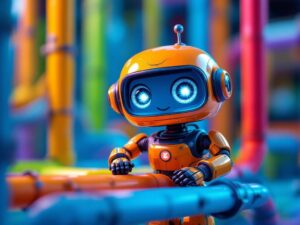Storytelling has been an intrinsic part of human culture since time immemorial. It has the power to captivate, inspire, and transport us to different worlds. With the advent of generative Artificial Intelligence (AI), storytelling is undergoing a profound transformation. AI models are now capable of generating original narratives, personalizing stories, facilitating collaborative storytelling, and a lot more. Let’s explore how generative AI is reshaping the landscape of storytelling and discuss the potential implications of generative AI.
Table of Contents
ToggleContent Creation: Augmenting Human Creativity
Generative AI is revolutionizing content creation by augmenting human creativity. AI models such as OpenAI’s ChatGPT can generate original stories, scripts, and poems based on provided prompts or parameters. These AI-generated narratives can serve as a source of inspiration for writers, content creators, and game developers, offering fresh ideas and helping overcome creative blocks. While AI-generated content may lack the depth of human emotion and experience, it can provide a starting point or a new perspective that stimulates further creative exploration.
Personalization: Tailoring Stories for Individual Readers
One of the most significant contributions of generative AI to storytelling is personalization. By analyzing user preferences, behavior, and demographic data, AI can create personalized narratives that cater to individual readers or users. This enhances the storytelling experience by making it more relevant, engaging, and relatable. Imagine a digital story that dynamically adapts its plot, characters, or settings based on the reader’s interests and context, creating a unique and immersive experience for each individual.
Interactive Narratives: Engaging Users in Dynamic Worlds
Generative AI enables the creation of interactive narratives that engage users in dynamic and responsive storytelling experiences. AI-powered chatbots and virtual characters can understand user inputs and generate contextually appropriate responses, blurring the line between fiction and reality. This paves the way for interactive storytelling in video games, virtual reality experiences, and conversational agents, where users can actively shape the narrative through their choices and interactions. The result is a heightened sense of agency and immersion, transforming storytelling from a passive experience to an active and participatory one.
Collaborative Storytelling: Fostering Co-Creation and Innovation
Generative AI facilitates collaborative storytelling by allowing multiple contributors to work together in real-time. AI models can generate suggestions, plot twists, or character ideas based on input from different users. This fosters co-creation and collective imagination, where individuals can build upon each other’s ideas, leading to innovative and unpredictable narratives. Collaborative storytelling platforms powered by generative AI provide a space for collective creativity, enabling communities to create stories together, transcending boundaries and cultural barriers.
Language Translation and Adaptation: Expanding Storytelling Horizons
Generative AI models are invaluable tools for language translation and adaptation in storytelling. They can automatically translate stories into different languages, making them accessible to diverse audiences worldwide. Furthermore, AI can adapt stories from one medium to another, such as converting a book into a screenplay or a video game script. This ability to bridge linguistic and format gaps expands the reach and impact of stories, fostering cultural exchange and diversity in the storytelling landscape.
Automated Editing and Proofreading: Enhancing Quality and Efficiency
Generative AI models can assist in the editing and proofreading process, improving the quality and efficiency of written content. AI-powered tools can identify grammar and spelling errors, suggest alternative phrasing, and provide feedback on the overall structure and coherence of a story. This streamlines the editing process, saving time and effort for writers and editors. While AI cannot replace human editorial judgment, it can be a valuable collaborator in refining and polishing stories.
Conclusion
Generative AI is revolutionizing storytelling by augmenting human creativity, enabling personalization, fostering interactivity and collaboration, expanding linguistic horizons, and enhancing editing and proofreading processes. However, AI models are not yet capable of fully replicating human creativity, emotional depth, and the ability to connect with the audience. The human touch remains a fundamental aspect of storytelling that AI cannot replace. Nevertheless, as AI technology continues to advance, it will undoubtedly have an increasingly significant impact on the storytelling landscape.
The key lies in leveraging generative AI as a powerful tool to complement and enhance human creativity, unlocking new storytelling possibilities, and bringing forth innovative narratives that captivate and inspire us in ways we have never experienced before. If you’re looking to improve your storytelling as well as productivity using generative AI, then do check us out at www.straico.com


